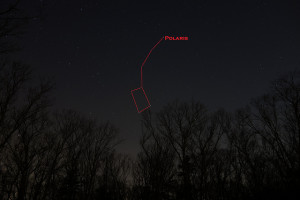

Learn the characteristics and locations of The Big Dipper, Cassiopeia, Orion, Leo, Pegasus, and Crux. Of course, where a star atlas really proves its worth is if it makes you familiar enough with the night sky that you don't need the atlas.Make sure you get lots of practice so, if you need to find the North Star in a pinch, you're well-prepared to use your atlas. It can take a while to get proficient at using a star atlas. Practice using the star atlas before you go camping.Bring a flashlight with you as you go out to stargaze so you can consult the map as needed. Select the map for your specific region and time of year and use that map as a guide. A star atlas will provide a map, much like a map of a town or city, guiding you across the night sky on any given night.Major stars, like the North Star, may be marked by large, red dots. For example, small stars may be labeled by dots. There's usually a guide in back that provides information on how constellations are labeled. Every star atlas is slightly different.You can use the graphics and charts provided in a star atlas to locate the North Star on any given night. A star atlas is a book that breaks down the night sky by the region and time of year. You should also always take an atlas with you when hiking in the event your phone battery dies.

If the idea of carrying your phone around while stargazing kills the fun for you, consider buying a star atlas instead. Star atlases have been around for a long time. Note that you will have to actually see the North Star for this method to work. You should eventually land on a somewhat bright star. Follow the direction of the arrow forward. Look at this point as if it were an arrow. The three stars that form the middle portion of the "M" or "W" can be used to roughly locate the North Star.In earlier hours, the constellation looks more like an "M." Between midnight and dawn, the constellation looks more like a "W." In the months of February and March, Cassiopeia is especially likely to appear as a "W." X Research source Cassiopeia is a constellation that consists of five stars.Fortunately, you can use the constellation Cassiopeia to locate the North Star. However, if the Big Dipper is low in the sky it can be difficult. Using the Big or Little Dipper are the most common means to locate the North Star. Rely on the arrow in the Cassiopeia constellation. That point is less than three degrees from the North Star and the North Celestial Pole. If clouds or trees or mountains are in the way, the North Star is still there near the end of the fifth pointer length. Note that you do not actually have to see the North Star with this method.You should eventually reach a somewhat bright star. Extend that line five times the distance between the pointer stars. These are the "pointer stars." Draw an imaginary line connecting the pointer stars.

To do so, look at the two bright stars that form the side of the bowl farthest away from the handle's tip.

Four stars form a trapezoid-like shape, the bowl portion. The Big Dipper is given its name because it's shaped somewhat like a bowl with a handle.In the autumn and winter months, it'll be lower in the sky. In the spring and summer months, the Big Dipper will be somewhat high in the sky. The constellation is found in the northern sky. The Big Dipper is a constellation made up of seven stars. The Big Dipper contains stars known as "pointer stars," which can be used to locate the North Star. You can easily locate the North Star by using the Big Dipper.


 0 kommentar(er)
0 kommentar(er)
